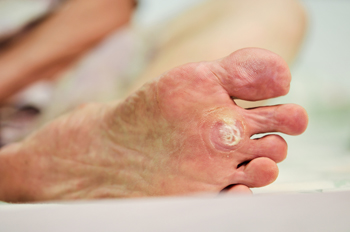 Common warts are caused by the human papillomavirus, which is known as HPV. The top layer of the skin becomes thickened and grows outward and will typically appear as a small bump. A plantar wart also originates from the same virus, and the exception is that it grows inward on the heel of the foot. This is typically a result of the pressure the heels endure from consistent walking and standing for the majority of the day. This condition is commonly accompanied by severe pain and discomfort. Therefore, walking may be difficult. It may appear as a hardened area on the heel of the foot, and may have small blood vessels in the center, which appear as tiny black dots. If you feel you have a plantar wart, it’s advised to speak to a podiatrist as quickly as possible, so proper treatment techniques can commence.
Common warts are caused by the human papillomavirus, which is known as HPV. The top layer of the skin becomes thickened and grows outward and will typically appear as a small bump. A plantar wart also originates from the same virus, and the exception is that it grows inward on the heel of the foot. This is typically a result of the pressure the heels endure from consistent walking and standing for the majority of the day. This condition is commonly accompanied by severe pain and discomfort. Therefore, walking may be difficult. It may appear as a hardened area on the heel of the foot, and may have small blood vessels in the center, which appear as tiny black dots. If you feel you have a plantar wart, it’s advised to speak to a podiatrist as quickly as possible, so proper treatment techniques can commence.
Plantar warts can be very uncomfortable. If you need your feet checked, contact Dr. John P. Beaupied from Palos Podiatry. Our doctor will assist you with all of your foot and ankle needs.
About Plantar Warts
Plantar warts are the result of HPV, or human papillomavirus, getting into open wounds on the feet. They are mostly found on the heels or balls of the feet.
While plantar warts are generally harmless, those experiencing excessive pain or those suffering from diabetes or a compromised immune system require immediate medical care. Plantar warts are easily diagnosed, usually through scraping off a bit of rough skin or by getting a biopsy.
Symptoms
- Lesions on the bottom of your feet, usually rough and grainy
- Hard or thick callused spots
- Wart seeds, which are small clotted blood vessels that look like little black spots
- Pain, discomfort, or tenderness of your feet when walking or standing
Treatment
- Freezing
- Electric tool removal
- Laser Treatment
- Topical Creams (prescription only)
- Over-the-counter medications
To help prevent developing plantar warts, avoid walking barefoot over abrasive surfaces that can cause cuts or wounds for HPV to get into. Avoiding direct contact with other warts, as well as not picking or rubbing existing warts, can help prevent the further spread of plantar warts. However, if you think you have developed plantar warts, speak to your podiatrist. He or she can diagnose the warts on your feet and recommend the appropriate treatment options.
If you have any questions please feel free to contact our office located in Palos Heights, IL . We offer the newest diagnostic and treatment technologies for all your foot and ankle needs.



